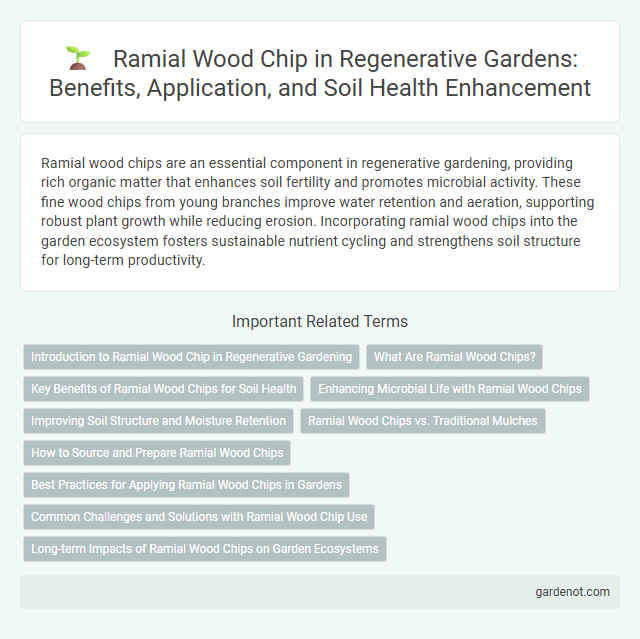Ramial wood chips are an essential component in regenerative gardening, providing rich organic matter that enhances soil fertility and promotes microbial activity. These fine wood chips from young branches improve water retention and aeration, supporting robust plant growth while reducing erosion. Incorporating ramial wood chips into the garden ecosystem fosters sustainable nutrient cycling and strengthens soil structure for long-term productivity.
Introduction to Ramial Wood Chip in Regenerative Gardening
Ramial wood chips are made from the small branches and twigs of deciduous trees, rich in nutrients and beneficial microbes essential for soil health. These chips enhance soil structure, promote microbial diversity, and accelerate organic matter decomposition, making them ideal for regenerative gardening practices. Incorporating ramial wood chips supports plant growth by improving moisture retention and nutrient cycling within the garden ecosystem.
What Are Ramial Wood Chips?
Ramial wood chips are small, nutrient-rich wood fragments derived primarily from young branches and twigs of deciduous trees, typically less than 7 centimeters in diameter. These chips are highly valued in regenerative gardening for their ability to enhance soil structure, boost microbial activity, and provide a slow-release source of essential nutrients like nitrogen, calcium, and potassium. Using ramial wood chips as mulch or soil amendment promotes healthy root development and supports sustainable, carbon-sequestering garden ecosystems.
Key Benefits of Ramial Wood Chips for Soil Health
Ramial wood chips enhance soil health by improving moisture retention, aeration, and nutrient cycling through their high content of easily decomposable fibers and lignin. These chips stimulate beneficial microbial activity, leading to increased organic matter and improved soil structure. Their slow decomposition rate gradually releases essential nutrients, promoting sustained fertility and supporting robust plant growth in regenerative gardens.
Enhancing Microbial Life with Ramial Wood Chips
Ramial wood chips significantly boost soil microbial diversity by providing a rich source of nutrients and organic matter, essential for thriving microbial communities. These chips enhance the proliferation of beneficial fungi, bacteria, and actinomycetes, which improve nutrient cycling and soil structure. Incorporating ramial wood chips into regenerative gardens promotes a balanced and healthy soil ecosystem vital for plant growth and ecosystem resilience.
Improving Soil Structure and Moisture Retention
Ramial wood chips enhance soil structure by increasing organic matter content, promoting aggregation and improving porosity in regenerative gardens. This improved soil structure facilitates better water infiltration and retention, reducing evaporation and supporting moisture availability for plant roots. The nutrient-rich decomposition process also boosts microbial activity, further enhancing soil health and moisture management.
Ramial Wood Chips vs. Traditional Mulches
Ramial wood chips, derived from young, small-diameter wood branches, offer superior nutrient release and soil microbe support compared to traditional mulches made from bark or wood waste. Their high nitrogen content and diverse organic compounds accelerate decomposition, enhancing soil fertility and structure. Unlike conventional mulches that primarily serve as weed barriers, ramial wood chips actively regenerate soil biology and improve moisture retention in regenerative gardens.
How to Source and Prepare Ramial Wood Chips
Ramial wood chips are best sourced from small-diameter twigs and branches of deciduous hardwood trees such as maple, oak, or birch, typically less than 7 centimeters in diameter to ensure high nutrient content and rapid decomposition. To prepare ramial wood chips, collect freshly pruned branches, chip them using a wood chipper, and allow them to partially decompose or compost briefly before application to enhance microbial activity and soil health in regenerative gardens. Properly prepared ramial wood chips improve soil structure, increase organic matter, and support beneficial microbial populations essential for sustainable garden ecosystems.
Best Practices for Applying Ramial Wood Chips in Gardens
Ramial wood chips, derived from young hardwood branches, enhance soil fertility by improving microbial activity and nutrient cycling when applied as mulch. Best practices for applying Ramial wood chips in gardens include spreading a 2- to 4-inch layer evenly around plants, avoiding direct contact with stems to prevent rot. Incorporating chips during cooler seasons like spring or fall maximizes decomposition and soil enrichment, promoting sustainable plant growth.
Common Challenges and Solutions with Ramial Wood Chip Use
Ramial wood chips often present challenges including slow decomposition in compacted soils and potential nitrogen immobilization, which can inhibit plant growth. To mitigate these issues, incorporating microbial inoculants and mixing chips with nitrogen-rich materials like green manure enhances decomposition rates and nutrient availability. Regular monitoring of soil moisture and aeration improves microbial activity, ensuring effective integration of ramial wood chips in regenerative garden practices.
Long-term Impacts of Ramial Wood Chips on Garden Ecosystems
Ramial wood chips significantly enhance soil structure and biodiversity by increasing organic matter and microbial activity, promoting nutrient cycling and water retention in garden ecosystems. Over time, these chips support the development of healthy mycorrhizal networks, which improve plant resilience and growth. Long-term use of ramial wood chips also reduces the need for chemical fertilizers and irrigation, leading to more sustainable and regenerative gardening practices.
Ramial wood chip Infographic

 gardenot.com
gardenot.com